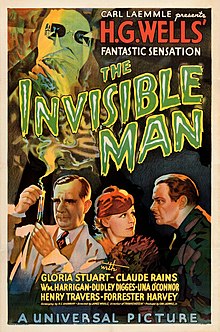
Back الرجل الخفي (فيلم 1933) Arabic الرجل الخفى ARZ Neviditelný muž (film, 1933) Czech The Invisible Man Welsh Der Unsichtbare (1933) German El hombre invisible (película) Spanish Nähtamatu mees (film) Estonian The Invisible Man (1933ko filma) Basque مرد نامرئی (فیلم ۱۹۳۳) Persian Näkymätön mies (elokuva) Finnish
| The Invisible Man | |
|---|---|
 | |
| Directed by | James Whale |
| Screenplay by | R. C. Sherriff[2] |
| Based on | The Invisible Man 1897 novel by H. G. Wells[2] |
| Produced by | Carl Laemmle Jr.[2] |
| Starring | |
| Cinematography | Arthur Edeson |
| Edited by | Ted Kent[2] |
| Music by | Heinz Roemheld |
Production company | |
| Distributed by | Universal Pictures Corp. |
Release date |
|
Running time | 70 minutes[2] |
| Country | United States[3] |
| Language | English |
| Budget | $328,033 |
The Invisible Man is a 1933 American science fiction horror film directed by James Whale based on H. G. Wells's 1897 novel, The Invisible Man, produced by Universal Pictures, and starring Gloria Stuart, Claude Rains and William Harrigan. The film involves a Dr. Jack Griffin (Rains) who is covered in bandages and has his eyes obscured by dark glasses, the result of a secret experiment that makes him invisible, taking lodging in the village of Iping. Never leaving his quarters, the stranger demands that the staff leave him completely alone until his landlady and the villagers discover he is invisible. Griffin goes to the house of his colleague, Dr. Kemp (William Harrigan) and tells him of his plans to create a reign of terror. His fiancée Flora Cranley (Gloria Stuart), the daughter of his employer Dr. Cranley (Henry Travers), soon learn that Griffin's discovery has driven him insane, leading him to prove his superiority over other people by performing harmless pranks at first and eventually turning to murder.
The Invisible Man was in development for Universal as early as 1931 when Richard L. Schayer and Robert Florey suggested that Wells' novel would make a good follow-up to the studio's horror film hit Dracula. Universal opted to make Frankenstein in 1931 instead. This led to several screenplay adaptations being written and a number of potential directors including Florey, E.A. Dupont, Cyril Gardner, and screenwriters John L. Balderston, Preston Sturges, and Garrett Fort all signing on to develop the project intending it to be a film for Boris Karloff. Following Whale's work on The Old Dark House starring Karloff and The Kiss Before the Mirror, Whale signed on and his screenwriting colleague R.C. Sherriff developed a script in London. Production began in June 1933 and ended in August with two months of special effects work done following the end of filming.
On the film's release in 1933, it was a great financial success for Universal and received strong reviews from several trade publications, and likewise from The New York Times, which deemed it one of the best films 1933. The film spawned several sequels that were relatively unrelated to the original film in the 1940s. The film continued to receive praise on re-evaluations by critics such as Carlos Clarens, Jack Sullivan, and Kim Newman, as well as being listed as one of their favorite genre films by filmmakers John Carpenter, Joe Dante, and Ray Harryhausen. In 2008, The Invisible Man was selected for the United States National Film Registry by the Library of Congress as being "culturally, historically, or aesthetically significant".[4]
© MMXXIII Rich X Search. We shall prevail. All rights reserved. Rich X Search